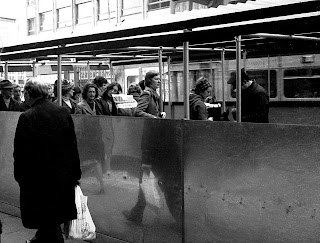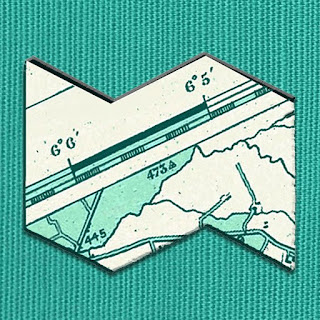The following was written for the programmes of Kabosh Theatre's 'Belfast by Moonlight' written by Carlo Gebler, stages in St George's Church. Also included here is a recording of the presentation given at the after-show discussion on 23rd October 2013.
I met Auld George on a dull, muggy day, walking across his courtyard and leaving the uneasy traffic flow of High Street behind; the chaotic, multipurpose deluge at odds with the singular unending flow of the silent river beneath the street.
Standing at the gates I imagine what he would have looked like had the fortunes of the Earl Bishop of Derry been happier. Originally envisioned as a simple squat, yellow-grey sandstone prayer box, Auld George received his new grandly classical face when the Earl Bishop died during the construction of his new house. The finely crafted pediment, distinctly Athenian in appearance, was hauled all the way from Castledawson and was pulled up the Farset by barges to be fixed to Auld George’s facade. His plain face, slightly curved in the centre, is transformed into bold late Georgian classicism, perhaps more befitting of the ornate rituals of the Anglican tradition within.
Before approaching Auld George I glance at the city around him and consider how, despite being so enmeshed in Belfast and it’s past, he seems to sit apart from the city; in the city but not of it. Set back from High Street and protected by three substantial trees, George seems to be putting himself at arms length; perhaps knowing that the greatest service he renders is to provide respite for weary citizens of this tiresome urbanity. To his right he looks onto the backs of the early Victorian terraces on Church Lane; all Bangor Blue, Belfast brick and cast iron downpipes. To his left, he is overshadowed by faceless apartment blocks, as alien to the city as George but lacking his self-awareness and humility. They lean over him in a vain attempt at intimidation, but Auld George is more robust than that.
Facing him is the High Victorian clock known as Albert and it’s modernist counterpart Transport House; friendly faces sympathetic to George’s plight. They too are interlopers from another Belfast. I scan around to the mouth of Bridge Street in the near distance and marvel at how the National Bank Building has survived the blitzkrieg when Arnotts had been flattened to one side and Imperial Buildings to the other had lost it’s head. Returning my gaze to Auld George I consider the close call he had on that grim night in April; that night he lost his school house and watched friends and neighbors burn and fall.
I walk through his grand doors, cross the shallow vestibule and pause before entering his church-proper. The short corridor in which I find myself is littered with the peripheries of worship. Bibles, hymnals, tracts and prayer cushions remind the architectural tourist that Auld George is no archeological artifact, but a living, breathing place of worship. As his door whispers open I slip behind his facade and I am face to face with Auld George himself. The street noise disappears and silence envelopes me. His hard stone floor squeaks under my trainers and I slow my gait, considering each step to guard against the conspicuous noise, almost profane against the din of silence. Even Auld George’s materiality politely requests your respect; material properties which have no doubt heavily contributed to the church’s musical liturgy.
George’s interior itself is as simple and functional as his facade would have been had it not been added to. A demure tiled grey stone floor neatly meets white plastered walls lined with windows with shallow curved heads, four on each side, mostly simple wired glass with a few embellished with delicate stained images. A narrow balcony spans three edges of the room, simply supported by columns with gold-painted corinthian heads; the heads most likely being a late Victorian addition. A second row of large grand windows bathe the space in an even coverage of natural light and offer glimpses of the city beyond. Rows of simple timber pews face an ornate chancel, undoubtedly Auld George’s focal point.
The chancel stands in direct opposition to the austerity of the rest of the hall. The three tall stained glass windows give the presbytery a phosphorescence, an almost ethereal glow. The double-height space is adorned with gold-leaf and medieval style religious murals. The ornamentation draws the eye upwards to exposed timber trusses, painted white and patterned with green stenciled leaves; work completed by architect W.J. Barre, contemporary and rival of the great Charles Lanyon.
I slowly lap the nave, examining the stained glass windows and several memorial plaques inscribed with names I regret I do not know; James Halliday Neill, Sarah May Nelson McTear, John Quiller Lane. And a few I do know, Sir Robert Hugh Hanley Baird, Sir Henry Pottinger; family names spread throughout the city and yet another chunk of Belfast history held by dear Auld George.
I slip into an empty pew and the timber groans under my weight and I sit silently still, only moving if I dare. The silence once again returns and I calmly gaze at my surroundings. The total lack of audio creates a sense of alienation. The empty hall into which I stare could almost be a photograph, I look closely at a candle resting on a nearby cill and I swear it is not even flickering. I try not to let it unnerve me and endeavor to use this lack of sensual stimulation to allow me to see better.
My eyes return to the gaudy late Victorian chancel and find it overloading my mind. I close my eyes and I’m gone, not to somewhere else but to some different stream of experience, stripping out the everyday context of the church and replacing it with the much richer context of Belfast itself.
I see High Street as it would have been, a dirt track running along the south bank of the Farset ending where the stream discharges into the mighty Lagan; the river bed just about visible beneath the rushing waters. Given time and tide the shifting sandbank ford would thrust up through the flow permitting passage to the other bank; a journey far from guaranteed however. The unpredictable Lagan would sometimes surge, washing pilgrims out into the lough. The last piece of dry land, therefore, became an important waypoint; a place of thanksgiving for a successful journey, or a place of prayer for the journey to come.
Given the volumes of pilgrims wishing to cross the river, Auld George is established as a permanent place of worship, although it would be a long time before he is given that name; being originally referred to simply as the Chapel of the Ford. A small village grows along the rough dirt track, which eventually becomes a place with a name, that name being Beal Fierste, the approach to the ford. I see the small village expanding as people establish markets, at first to provide the pilgrims with much needed respite on their journey, and later to profit from them. A stronghold is constructed, a satellite castle to the much larger Carrickfergus. The crossing itself becomes commodified, pilgrims now need to ask the king of the castle for safe passage before asking Auld George for the mercy of the elements.
I see the settlement expanding, coming under control of English planters, it’s name shifting to Belfast, an anglicised version of the more musical gaelic. Land is slowly reclaimed from the surging Lagan and Auld George’s connection with the water dwindles. As the city rises in importance, however, so does Auld George. When the city is made that slick profit-making-machine referred to as the Belfast Corporation, Auld George becomes the chapel of choice for the Burgesses, being recast as the Corporation Church.
The sometimes cartoonish, often tragic politics of Ireland played out around Auld George and he sat on, paying it no mind but often acting as a backdrop. Cromwell’s forces occupied and garrisoned Auld George, defacing and damaging his fabric considerably. Several years later King William himself, on his way from Carrickfergus to face King James at the Boyne, was George’s guest of honor, while a century later the martyred remains of Henry Joy were interred in his graveyard. Auld George welcomed in heroes and villains, blackguards and white knights, showing neither favouritism nor bias.
The aforementioned graveyard, so Cathal O’Byrne tells us, was closed in the early 1800s as the grounds were liable to flooding. O’Byrne goes on to bemoan the defilement of the graves by the rebuilding and extension of Auld George, a fact reinforced by a discussion had with a church member who described an incident which occurred during minor building works. A skeleton was found in the sitting position in the centre of the nave underneath the central walkway, and it remains there to this day. Sitting there in the silence, my eyes slowly opening, I can think of no better place to be laid to rest.
As I leave Auld George behind I am struck by how closely his story is connected to Belfast, the church acting as synecdoche for the entire city. When Belfast flourished so did the church; when Belfast suffered Auld George suffered too; and through the tumult and upheaval he sits on in quiet humility. Unlike his saintly namesake Auld George does not slay the dragons, but rather endures them and by the sheer act of remaining, defeats them.

























